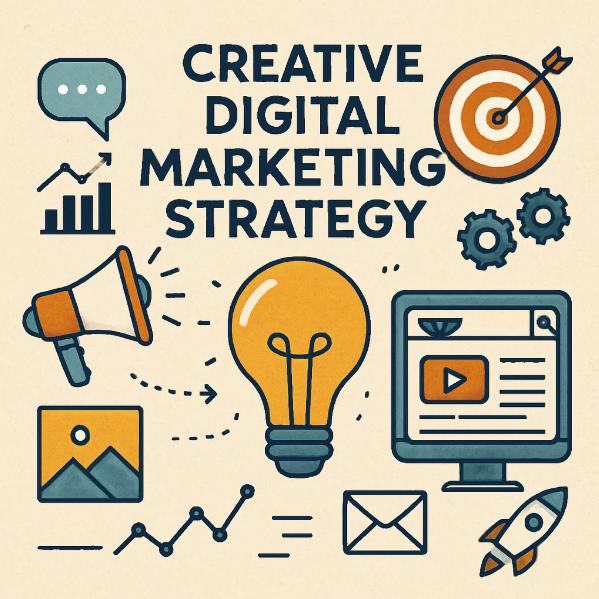Creative digital marketing is the art of using innovative ideas and technology to engage audiences in new and exciting ways. It involves rethinking traditional marketing tactics and embracing digital platforms to deliver compelling messages. As digital marketing continues to evolve, creativity becomes a key differentiator for brands seeking to stand out in a crowded marketplace.
Defining the Core Principles
To truly grasp creative digital marketing, one must first understand its core principles. These include adaptability, where brands must be nimble in response to technological changes and consumer behavior shifts. Another principle is authenticity; consumers crave genuine interactions, making it essential for brands to communicate honestly and transparently. Lastly, creativity itself is a fundamental principle, driving the innovation needed to break through the noise of the digital world.
The Evolution of Digital Marketing
Digital marketing has undergone significant evolution over the years. Initially, it was about establishing an online presence through websites and emails. As social media platforms emerged, they became pivotal in shaping how brands interact with their audiences. Today, the integration of AI, AR, and VR is pushing the boundaries further, allowing for more personalized and immersive experiences. Understanding this evolution helps marketers anticipate future trends and prepare accordingly.

The Importance of Data-Driven Strategies
Data is at the heart of modern digital marketing. By leveraging data analytics, marketers can gain insights into consumer behavior, preferences, and interactions. This allows for the creation of highly targeted and effective marketing campaigns. Employing a data-driven strategy ensures that marketing efforts are not only creative but also aligned with measurable outcomes, enhancing the return on investment.
The Role of Content Marketing
Content marketing is the backbone of any successful digital marketing strategy. It involves creating valuable, relevant content to attract and engage target audiences. This approach not only builds brand awareness but also fosters trust and loyalty among consumers.
Storytelling: Crafting Narratives that Resonate
Storytelling is a powerful tool in content marketing, enabling brands to connect with audiences on an emotional level. When a brand crafts a story that resonates with its target market, it creates a memorable experience that drives engagement and conversion. These stories can take many forms, from blog posts and videos to podcasts and social media updates, each with the potential to evoke emotion and inspire action.
Harnessing User-Generated Content
User-generated content (UGC) is a game-changer for brands looking to amplify reach and authenticity. Encouraging customers to share their own content related to a brand not only expands visibility but also serves as social proof. UGC showcases real experiences, helping to build trust among potential customers. This type of content can be shared across multiple platforms, creating a ripple effect that enhances brand credibility.
The Power of Interactive Content
Interactive content such as quizzes, polls, and interactive infographics can significantly boost engagement. By encouraging users to actively participate in the content experience, brands can capture attention and foster deeper connections. Interactive content also provides valuable insights into consumer preferences and behavior, allowing for more personalized marketing strategies. This type of content is not only engaging but also highly shareable, further extending its reach.
Embracing Digital Advertising Innovation
Digital advertising has come a long way, with new technologies and platforms continually reshaping the landscape. Staying ahead requires a willingness to experiment with these innovations and adapt strategies accordingly.
Programmatic Advertising: Precision and Efficiency
Programmatic advertising uses automated technology to buy and place ads in real-time. This approach allows marketers to target specific audiences with precision, optimizing ad spend and improving ROI. By leveraging data and machine learning, programmatic advertising can deliver highly relevant ads to the right people at the right time. This level of precision ensures that marketing messages are not only seen but also acted upon.
The Impact of Augmented Reality (AR) and Virtual Reality (VR)
AR and VR technologies offer immersive experiences that captivate audiences and create lasting impressions. Brands are increasingly using these technologies in digital advertising to provide interactive experiences, such as virtual try-ons or 360-degree product views. The immersive nature of AR and VR not only grabs attention but also helps consumers make informed purchasing decisions. This innovative approach to advertising is changing the way consumers interact with brands.
Artificial Intelligence (AI) Revolutionizing Digital Advertising
AI is revolutionizing digital advertising by enabling personalized and data-driven campaigns. From chatbots to predictive analytics, AI tools can enhance customer interactions and optimize ad performance. By analyzing consumer data, AI can identify patterns and preferences, allowing marketers to tailor their messaging and improve targeting. This results in more effective campaigns that resonate with audiences on a deeper level.
Leveraging Emerging Technologies in Marketing

As technology continues to advance, new opportunities for creative digital marketing emerge. By embracing these innovations, businesses can stay ahead of the competition and deliver exceptional customer experiences.
Blockchain: Enhancing Transparency and Trust
Blockchain technology, known for its role in cryptocurrencies, is gaining traction in marketing for its ability to enhance transparency and trust. By providing a secure and decentralized way to track transactions and data, blockchain can help marketers build credibility and protect consumer privacy. This technology offers a new level of accountability, ensuring that marketing efforts are both ethical and effective.
Optimizing for Voice Search
With the rise of voice-activated devices, optimizing for voice search is becoming increasingly important. This involves understanding how people phrase queries when using voice assistants and tailoring content to match these conversational search patterns. By optimizing for voice search, brands can improve visibility and capture the attention of voice-enabled device users. This approach is essential for staying relevant in an era where voice interactions are becoming commonplace.
The Promise of 5G Connectivity
The rollout of 5G networks promises to revolutionize digital marketing by enabling faster data transfer and improved connectivity. This advancement opens up new possibilities for real-time marketing, enhanced mobile experiences, and seamless integration of IoT devices. With 5G, marketers can deliver more dynamic and interactive content, ensuring that audiences receive timely and relevant information. This connectivity will redefine how brands engage with consumers.
Strategies for Implementation
Implementing innovative digital marketing strategies requires a thoughtful approach. Here are some key considerations for businesses looking to integrate these strategies into their marketing efforts:
Staying Informed and Engaged
Keeping up with the latest trends and technologies in digital marketing is essential. Attend industry conferences, read relevant publications, and engage with thought leaders to stay ahead of the curve. This proactive approach ensures that marketers are equipped with the knowledge needed to navigate the ever-changing digital landscape. Continuous learning and engagement are vital for maintaining a competitive edge.
The Importance of Testing and Experimentation
Be willing to experiment with new ideas and technologies. Conduct A/B testing to identify what works best for your audience and be open to pivoting strategies based on performance data. Testing allows marketers to refine their approaches, ensuring that campaigns are both innovative and effective. This willingness to adapt and learn from failures is a crucial component of successful digital marketing.
Aligning with Business Goals
Ensure that your digital marketing efforts align with broader business objectives. By integrating marketing strategies with overall business goals, you can drive growth and achieve sustainable success. This alignment ensures that marketing initiatives support the company’s vision and mission, contributing to a cohesive strategy that maximizes impact. Clear communication between marketing and other departments is essential for this alignment.
Investing in Skills and Talent
As digital marketing evolves, investing in skills development and hiring top talent becomes crucial. Equip your team with the knowledge and tools they need to succeed in the ever-changing digital landscape. This investment in human capital ensures that your team is prepared to tackle new challenges and leverage emerging technologies. Fostering a culture of continuous improvement and innovation will drive long-term success.
Conclusion
The world of creative digital marketing is full of opportunities for businesses willing to embrace innovation and think outside the box. By leveraging emerging technologies and adopting innovative strategies, brands can create memorable experiences that captivate audiences and drive results. Whether it’s through content marketing, digital advertising, or the integration of cutting-edge technologies, the key to success lies in staying informed, experimenting, and aligning with business goals. As the digital landscape continues to evolve, those who adapt and innovate will thrive in the age of creative digital marketing.




